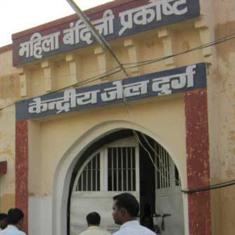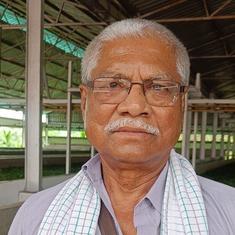In July, Hamida*, a resident of Manika block in Jharkhand’s Latehar district, had to add the names of her two children to her ration card. As the head of her household, 39-year-old Hamida had to ensure her sons – both under the age of 15 – are named on the ration to receive additional entitlements and other linked welfare schemes.
At the Common Service Centre, the operator told Hamida that a one time password, or OTP, was required to proceed with her application on the state’s Ration Card Management System portal. Hamida checked her phone several times but no OTP arrived. The operator then read the popup message on the screen that said her phone number had to be linked to her Aadhaar.
Hamida was confused. A few months before in December 2023, she had submitted an application to add her eldest son’s name to the ration card without entering an OTP.
What changed?
About a year ago during our usual field trips to study the public distribution system, we noticed some confusion and difficulties among people in changing their ration card details.
Earlier, only the ration card number and the Aadhaar number of the head of the household was needed to access the Jharkhand Ration Card Management System portal. Now, one also has to enter an OTP sent to the Aadhaar-linked mobile number of the head of the household to proceed with applications for name additions, deletions, corrections or updates.
Like Hamida, several others in Latehar district were unaware of the OTP requirement. This sudden change, with no proper information, has led to confusion, created an additional burden for the head of the household to get the mobile number linked to Aadhaar and will delay applications.
For users with limited digital literacy and access to technology, this is already a significant hurdle. But it especially affects women like Hamida who manage their homes with limited resources and are dependent on food rations.
The National Food Security Act includes a progressive mandate to designate the eldest woman in a household as the head of the household for ration card purposes. This provision recognises women’s central role in food security and aims to empower them by granting them greater control over essential entitlements. Introducing Aadhaar-based OTP authentication has inadvertently undermined this purpose by creating structural and systemic barriers that disproportionately affect women.
In this article, we have deliberately used the term “rightsholder” to emphasise that access to food entitlements under the National Food Security Act is not a favour or an act of benevolence by the state but a legal right. Recognising individuals as rightsholders shifts the focus on to the state’s responsibility to ensure equitable and accessible service delivery. With Aadhaar-based OTP authentication, this failure to recognise rightsholders exacerbates exclusion, particularly for women and economically vulnerable groups.
A digital maze
Aadhaar, a unique identification for residents, has become mandatory over the years to access most social protection programmes, crucially, the public distribution system. In India, an estimated 81 crore people rely on ration shops for subsidised food grains. In Jharkhand, around 2.86 crore people depend on ration shops.
The Centre claims that linking Aadhaar to the public distribution system will improve targeting, reduce leakages and corruption, thereby improving efficiency of the programme. Since 2015, Aadhaar has been integrated with the public distribution system with end-to-end computerisation of schemes, the automation of various processes and maintaining the online database of ration cards.
Jharkhand’s PDS control order, published in October 2024, mentions the added step of entering an Aadhaar-linked OTP to make changes in ration cards but does not explain why this is needed.
Discussions with stakeholders, including Common Service Centre operators and some block officials, found that most were unaware of the change and did not recognise the potential challenges for rightsholders. One state official interpreted this step as enhancing security to ensure there are genuine applications to make changes or deletions in the ration card.
Making changes in ration cards are important and are required from time to time as names have to be added or removed with every birth, wedding and death in the family. Such processes must be simple, transparent with enhanced accessibility and real time updates.
A ration card holder from Chorha panchayat in Sarayu block of Latehar district said she had been trying for a couple of months to get her name updated as the head of the household after her mother-in-law’s death. “I have gone to the Block office, and even to the district and a centre there multiple times, but I am not able to get my work done,” she said. “I have given up.”
Resolving complex issues becomes impossible if the Aadhaar is not already linked to a mobile number. We also came across several cases where the Aadhaar was not linked to mobile numbers in rural areas. These impediments add to the economic burden of those already leading precarious lives.
Rightsholders often have to travel to the block or district headquarters, since there are few centres to update Aadhaar details nearby, incurring transportation expenses as well as the loss of wages for that day.
If the Aadhaar centres are inaccessible or crowded, rightsholders are forced to seek help from intermediaries who charge exorbitant fees to complete simple tasks, such as linking Aadhaar with mobile numbers or updating ration card details. For instance, rightsholders in a village in Barhait reported paying between Rs 500 to as high as Rs 1,600 for services that are officially supposed to be free or minimally priced.
Another major challenge is the limited access of women to personal mobile phones, especially in rural areas. According to the National Family Health Service-5 (2019-21), 8.5% of households in India and 10% in Jharkhand do not have a mobile phone. There is also a major gender gap: Seven out of 10 non-mobile users are women, according to the 2023 Comprehensive Annual Modular Survey, by the National Sample Survey Office, which captures individual and household characteristics of mobile phone and internet usage. This gap widens with education and age and other factors such as owning a smartphone and using the internet.
Cultural norms and economic constraints prioritise men’s ownership of mobile devices, leaving women reliant on male family members. When women do have access to phones, their usage is limited. Many women who are the head of the household either have defunct mobile numbers linked to their Aadhaar or the mobile numbers of male relatives linked or no mobile number linked at all.
Even among those with mobile phones, the cost of maintaining an active connection, which increased around 15% in the last year, has created another layer of exclusion. We came across several economically disadvantaged households who have inactive or defunct mobile numbers due to unaffordable tariffs. This locks them out of the system since a functional mobile phone connection is now a prerequisite to accessing the Ration Card Management System portal to make changes.
Women are left with no choice but to depend on male relatives, undermining the autonomy that the National Food Security Act seeks to foster. In some cases, women reported paying middlemen exorbitant fees for simple updates.
These experiences highlight how a policy meant to empower women has instead widened the gender gap in access to food entitlements. By overlooking the structural inequities that limit women’s digital access and autonomy, the burden of compliance has inadvertently been shifted onto those who were supposed to gain from it. Ensuring women’s access to entitlements requires addressing these barriers holistically, beyond the technical fixes offered by Aadhaar integration.
Way forward
The digitisation of India’s public distribution system was envisioned as a leap towards efficiency and accountability but the reality on the ground tells a complex story.
Though technologies such as Aadhaar-based biometric authentication and OTP verification aim to prevent fraud and leakages, they exacerbate challenges for vulnerable populations who have poor digital literacy and limited access to mobile phones or the connectivity to navigate these systems.
There are not merely problems of technological access but broader concerns of digital and social inclusion, how rightsholders understand these processes and if they have skills to navigate the system that has been created. A fundamental question comes to the fore: does the state even recognise these rightsholders and how is it helping them?
A flexible and inclusive approach is necessary to ensure that the benefits of digitisation reach all rightsholders. Digitisation efforts must involve a consultation with various stakeholders and be rolled out after information about the changes are communicated to the rightsholders as clearly as possible.
At the same time, Jharkhand’s department of food and public distribution must provide necessary support to ensure ration card holders can navigate the changes easily without being faulted for struggling or facing difficulties. There should be multiple alternatives, in this case, like mobile numbers linked with the ration cards to get the OTP. In case there is no mobile number linked to the ration card or no mobile at all, there should be an offline system that can bypass the Aadhaar-based OTP. Procedures to update mobile phone numbers and Aadhaar details should also be simplified.
A balanced approach to digitisation should combine the efficiency gains of technology with a sensitivity to the lived realities of marginalised groups, ensuring that no one is left behind in the pursuit of a more secure and transparent public distribution system.
*Names changed for privacy.
Manisha Diggi, Sameet Panda and Vivek Gupta are associated with LibTech India, a centre at Collaborative Research and Dissemination. Opinions expressed in the article are personal.










